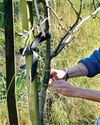
AS a student at horticultural college, I became used to performing repetitive tasks that were intended to fix routine gardening jobs into the memory of trainee gardeners. Countless seeds were sown in spring, while many hours were spent taking pelargonium cuttings in summer. The arrival of autumn was greeted with dread as it meant days of backbreaking double digging in a field of heavy clay.
After all that toil with a spade, squelching around in claggy soil, late winter offered a respite. It was time to unholster my trusty pair of secateurs and get to grips with some pruning. Huge beds planted with nothing else but roses were tackled, while berberis, cotinus and other deciduous shrubs that had started to outgrow their allotted space were thinned out or brought under control.
However, my favourite plants to tame were the ornamental dogwoods with their brightly coloured stems that grew, cheek​ by jowl, in the beds surrounding almost every college building. Once pruned, the red, yellow, green and sometimes two-tone shoots were gathered up and taken to a classroom to be used as material for hardwood cuttings.
Vivid display of stems
Every plant was given the same treatment by students. Stems were cut back incredibly hard to a permanent framework, leaving a knobbly cluster of stubs just above the ground. The reason for this seemingly brutal approach was twofold – to keep the shrubs compact and to ensure that the plants produced an equally vivid display of stems the following winter.
This story is from the {{IssueName}} edition of {{MagazineName}}.
Start your 7-day Magzter GOLD free trial to access thousands of curated premium stories, and 9,000+ magazines and newspapers.
Already a subscriber ? Sign In
This story is from the {{IssueName}} edition of {{MagazineName}}.
Start your 7-day Magzter GOLD free trial to access thousands of curated premium stories, and 9,000+ magazines and newspapers.
Already a subscriber? Sign In

To dig or not to dig?
Should we be carrying out a full dig on plots now? Bob considers the pros and cons of the 'autumn dig' debate

The box ball blues
As if his beleaguered box hadn't already taken a beating, Toby now has to deal with some hungry box caterpillars

Save your own seeds
Masterclass on: seed saving

Strange sightings
Three unusual insects turn up in Val's garden in one day

A bolt from the blue!
Cornflowers are perfect for garden and vase

Winter moth prevention
Ruth shows you how to avoid maggoty tree fruits

Create a winter container
There are as many options as in summer

Lightweight gardening tools
AS well as being good for our mental health, gardening is also great exercise.

Autumn price round-up
AG finds better bargains in lesser-known brands

Rudbeckias
Rudbeckias are ideal for sunny summer patios and borders, with some able to survive our coldest winters